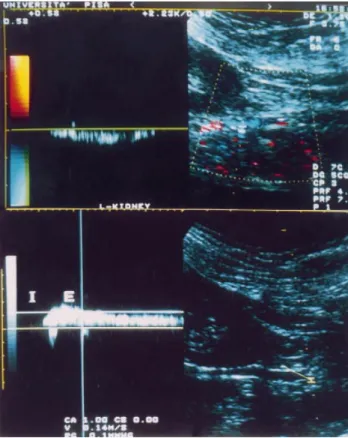Bleeding after renal biopsy resulting from a persisting left cardinal vein.
Testo completo
(2) 186. Fig. 1. ( Upper): Colour-Doppler mapping on longitudinal posterior scan. Evidence of perirenal haematoma (asterisk) and of the anomalous vessel in front of it (arrow). (Lower): Colour-Doppler after resolution of the haematoma. The anomalous vessel is closely located near the lower pole of the kidney.. M. Meola et al.. Fig. 2. ( Upper): The duplex analysis shows the slow but continuous flow of the vessel. (Lower): This venous flow is modulated by breathing in (I ) and breathing out ( E ). .. In conclusion, colour-coded Doppler evaluation of perirenal vasculature is useful to reveal rare abnormalities, as the presence of a left cardinal vein or other abnormal lumbar vessels.. Comment The present case shows that haematoma can occur even if the execution of renal biopsy is technical correct. In our case, severe bleeding was caused by accidental puncture of an abnormal venous vessel undetectable by B-mode standard scan. It was only subsequently revealed using the colour-coded Doppler sonography. In the adult, the presence of this vessel is infrequent. Anatomical studies in animals and humans showed that the persistence of right posterior cardinal vein, left supracardinal vein, or both right and left posterior cardinal veins are the most common types of anatomical variants, while the persistence of isolated left posterior cardinal vein occurs far less frequently [9]. This case suggests that the evaluation of the renal or perirenal vessels should be included in the evaluation of native kidney before a renal biopsy is performed. Colour-coded Doppler demonstration of vascular abnormalities should reduce the risk of bleeding complications.. References 1. Health and Public Policy Committee, American College of Physicians, Philadelphia. Clinical competence in percutaneous renal biopsy. Ann Intern Med 1988; 108: 301–303 2. Madaio MP. Renal biopsy. Kidney Int 1990; 38: 529–543 3. Meola M, Barsotti G, Cupisti A et al. Free-hand ultrasoundguided renal biopsy: report of 650 consecutive cases. Nephron 1994; 67: 425–430 4. Diaz-Buxo JA, Donadio JV Jr. Complications of percutaneous renal biopsy: an analysis of 1000 consecutive biopsies. Clin Nephrol 1975; 4: 223–227 5. Wickre CG, Golper TA. Complications of percutaneous needle biopsy of the kidney. Am J Nephrol 1982; 2: 173–178 6. Birnholz JC, Balakuntalam SK, Corwin HL. An improved technique for ultrasound guided percutaneous renal biopsy. Kidney Int 1985; 27: 80–82 7. Yoshimoto M, Fujisawa S, Sudo M. Percutaneous renal biopsy well-visualised by orthogonal ultrasound application using linear scanning. Clin Nephrol 1988; 30: 106–610 8. Barsotti G, Cupisti A, Morelli E et al. A special, supplemented ‘Vegan’ diet for nephrotic patients. Am J Nephrol 1991; 11: 380–385 9. McClure CFW, Butler EG. The development of the vena cava inferior in man. Am J Anat 1925; 35: 331–383 Received for publication: 29.7.98 Accepted in revised form: 9.9.98.
(3)
Figura

Documenti correlati
La rivista è edita dalla «Fondazione Spadolini Nuova Antologia» – costituita con decreto del Presidente della Repubblica, Sandro Pertini, il 23 luglio 1980, erede universale di
Alcune più recenti applicazioni ed esemplificazioni del disegno informa- tizzato, sembrano infatti quasi ricondu- cibili alla ricerca di un rinnovato legame con
The simulation and measurement of topological insulators in different quantum simulators is a very active field and different techniques allow one to char- acterize the
Three groups of isolated perfused hearts from adult Wistar rats underwent 30-min ischemia and 120-min reperfusion (I/R, Group 1), or were post-conditioned by brief ischemic
The introduction of dedicated clinical pathways, integrated care process management for COVID-19 patients and case managers are seen as reasonable healthcare practices by
We found that, in regular one-dimensional models, the confidence distribution obtained from the bias corrected log-likelihood ratio is third– order equivalent to the unique
In Fig 5b, invece, si osserva che, per il tubo incollato di lato 40mm la risposta della simulazione è più rigida nel primo tratto elastico a causa sia della cedevolezza
All'organismo sovrebbe inoltre spettare il compito di valutare ex ante l'idoneità delle misure proposte dal Governo, in primo luogo in sede di definizione della